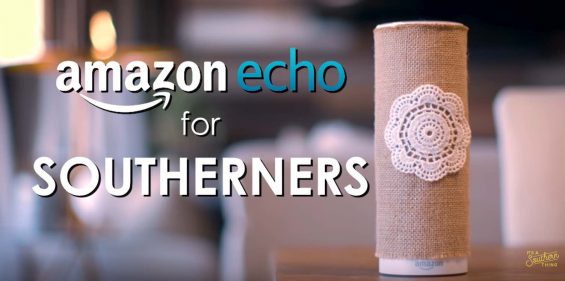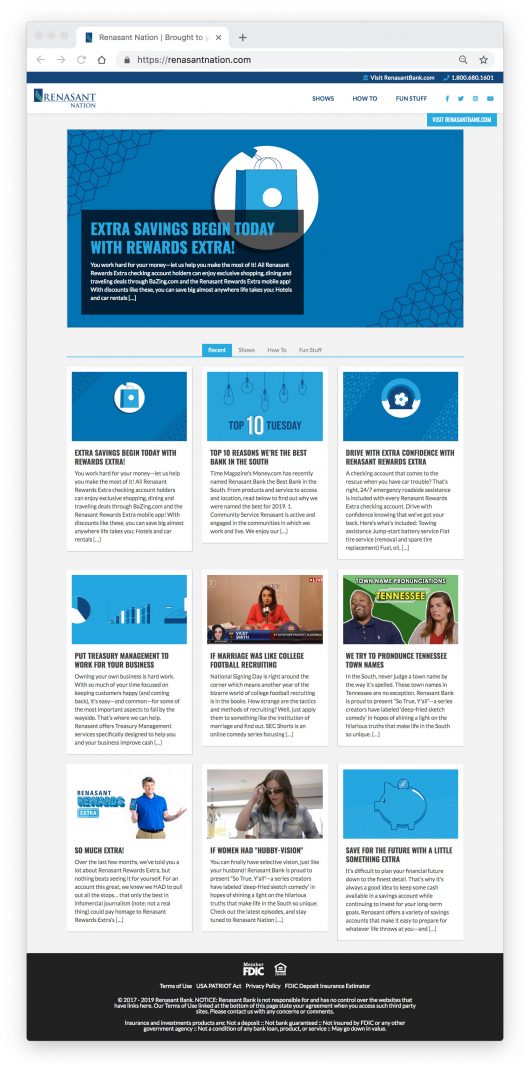A box arrives at a suburban home. A woman opens it to find a pair of “Hubby-Vision” goggles — a device guaranteed to reveal the way her husband sees the world. She unboxes the goggles and goes to throw out the carton, only to find the trashcan overflowing.
“Kevin,” she gripes to her husband, “I thought you said you were going to take the trash out!” He quips that there’s plenty of room left, as many husbands might. She pops on the goggles revealing that — in Hubby-Vision — the can is not only empty, but that the discarded box mysteriously evaporates when she tosses it on top of the pile.
More ensues — e.g., husbands don’t see sneakers in the middle of the floor. But then Kevin tries the goggles. Suddenly he sees where pictures hang crookedly. He appreciates subtlety in paint color on walls — “There really is a difference between Pebble Gray and Driftwood!” A good laugh, followed by a short message from Renasant Bank.
Less than a month after being published, it’s generated over 5 million video views.

Move the Needle from Attrition to Acquisition
Vericast’s 2024 Financial TrendWatch explores seven of today’s most critical financial services trends to provide a complete view of the current loyalty landscape.
Read More about Move the Needle from Attrition to Acquisition

The Power of Localized Marketing in Financial Services
Learn how to enhance your brand’s local visibility, generate more leads, and attract more customers, all while adhering to industry regulations and compliance.
Read More about The Power of Localized Marketing in Financial Services
Building a Microsite to Engage Customers
John Oxford had a challenge. As director of marketing for Renasant Bank, he felt the website for $12.9 billion institution looked good, but much of its messaging wasn’t getting across. Most customers would visit the site just long enough to log in to the online banking system. They were on a mission and not stopping for content.
“We needed to do something to get content about the bank in front of the audience,” Oxford says.
In the summer of 2017 the bank launched Renasant Nation, a separate microsite intended to deliver fun content on human interest topics in an effort to create greater brand awareness and connections to bank-specific content.
“It’s a content-driven relationship-building site,” explains Oxford, who will be speaking at the The Financial Brand Forum 2019. The bank, working with the Mabus Agency and others, blends stock video, custom footage, promotional videos, and financially-related content.
“Everything people see includes click-throughs that get them into a sales funnel,” according to Oxford. “We look for stuff that’s not commercial but that still has a brand hook for us. We want to give our brand a personality.”
The videos often open with a Renasant logo somewhere on the screen, and generally end with a short marketing message.
The results have been impressive, says Oxford, comparable to the kind of brand awareness that TV traditionally provided, but with more control and much more precise measurement that’s right at his fingertips.
The microsite depends heavily on traffic driven via Facebook and YouTube, rather than direct visits. The home page itself consists mainly of a tiled checkerboard view of the latest entertainment content, intermixed with more substantive information and instructional material, plus some advertising for the bank.
Even the one true “commercial” seen on the site recently features a tongue-in-cheek hard sell by “Downtown Danny Dinkler,” a fictional infomercial pitchman who spouts clichés like “But wait, there’s more!”
Creating Content People Will Actually Watch in The Netflix Age
Simply tapping the bank’s own experts to present financial education podcasts or something along those lines didn’t appeal to Renasant.
“That’s almost too salesy,” says Oxford, “and it’s almost too late for banks to do that kind of thing anymore.”
Renasant serves consumers and businesses in five southern states — Mississippi, Tennessee, Alabama, Florida and Georgia — and was named “Best Bank in the South” by Time Magazine’s Money.com. This cultural heritage is reflected in the variety of non-financial content that Renasant produces.
In “So True, Y’all”, a series of short comedic videos parody Southern culture, such as “If Self-Driving Cars Were Southern” and “If Alexa Were Southern.” Others have universal appeal, like “The Real Reason People Shop Online”.
There’s another series of short, often funny videos playing off of happenings in the Southeastern football conference — e.g., “What If The Playoff Semifinal Games Were Dates.” There’s also a three-part documentary about veteran Southern college baseball announcers.
In “Crafted By Renasant”, videos profile the bank’s business customers, focusing on firms that align well with Southern lifestyles — fishing lures handmade in Florida, a Mississippi camo hunting clothing manufacturer, and an Alabama craft brewer. A similar series called “Bootstrappers” is devoted to innovative outdoor products invented and made in the South, such as a “canine hydration backpack” for hunting dogs (the dog carries the backback, which includes a foldable bowl and built-in “guzzling hose”).
Oxford says he’s pitched on all sorts of new content ideas by the agency, bank staff, and over-the-transom producers. He’s said no to cooking shows — “it just wasn’t right for us” — and nonprofessional RV tours of the south shot on people’s smart phones. Whether the content is purchased from existing material or shot to the bank’s order, Oxford feels consistently professional look and feel is important. Sound and lighting quality make a big difference in appeal.
Turning Entertainment into a Business Strategy
Oxford says it wasn’t tough selling the strategy to management. The main requirement was to find ways to attract eyeballs without doing anything offensive that would tarnish the brand. Ultimately, the appeal comes down to three Cs, according to Oxford: Content that compels, Connection between people and the brand, and Conversion opportunities, over time.
Veteran marketer Oxford says a bank or credit union trying this strategy has to go into it understanding that it is about brand-building, not about producing directly trackable sales. “The demand for immediate ROI can kill creativity,” he explains, but it’s critical to remember that the brand is in the financial services business at the end of the day.
“There’s no hard ROI on this,” says Oxford. “This is a long-term play and not a short-term play.” This is typically how financial marketers look at traditional television spending, and he finds that branded video content works pretty much the same way in that regard.
All that said, Renasant isn’t spending money and devoting staff time with crossed fingers. Oxford and staff track things minutely, using tools available in Salesforce, Google Analytics, and more. Some content catches on immediately, and some takes a while, but when it does grab the public’s fancy the effort produces numbers.
“The Real Reason People Shop Online” episode of “So True, Y’all” resulted in over 3.5 million video views and around 200,000 “engagements”, including likes, comments and over 67,000 social shares. Another episode in that same series about the eight types of high school football moms also did well: roughly 4 million video views, 140,000 engagements, with more than 41,000 social shares.
Some subjects resonate a bit more locally, and don’t draw the same kinds of numbers — such as periodic takes on the unexpected ways locals pronounce their town names.
Oxford says the bank sees a 47% “bounce rate” on visits to the Renasant Nation microsite, but that still means more than half of all visitors stick around to look for other content after they’ve viewed what first drew them in.

The unfair advantage for financial brands.
Offering aggressive financial marketing strategies custom-built for leaders looking to redefine industry norms and establish market dominance.

Instant Messaging. Instant Impact.
Connect with your customers and provide lightning-fast support as effortlessly as texting friends. Two-way SMS text messaging is no longer optional.
Five Takeaways for Financial Marketers
Oxford shares some pointers for other financial marketers considering a video content program:
1. What to budget? Costs can vary, but for a community bank a good starting annual budget target is between $50,000 and $75,000. As a multi-state regional Renasant spends more. A similar-sized operation should be thinking of a six-figure budget, he advises.
2. Don’t be afraid to buy outside content. While exclusives produced to order can be fun, remember the point is not playing to your inner film director but producing results for the bank. Content already on the market can show proven appeal and has a following a financial brand can piggyback on.
3. Take some calculated content risk. Don’t be offensive, but don’t be boring, either. Oxford points out that financial advertisers like Capital One paved the way for using humor in banking spots.
4. Get used to exercising more control. Unlike traditional television, marketers can control most variables in a video content program. Using social media to draw in viewers puts the need for new content on the bank’s schedule, for example. The bank also enjoys brand protection in that it knows exactly what kind of material will be associated with its brand.
5. Don’t get product-heavy. Oxford stresses remembering that people are coming to the channel for a bit of entertainment. They can cut you off faster than a cable viewer with a remote, if you get too salesy.










